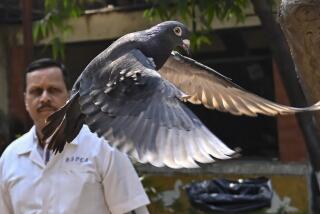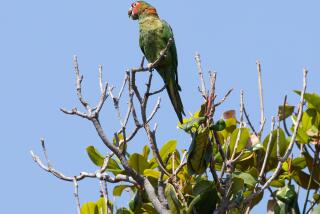Choreography Takes Wing in India’s Delhi
- Share via
NEW DELHI — When the sun is at its peak over the crumbling buildings of Delhi’s old city, and the midday call to prayer rings from a dozen mosques, a proud, soft-spoken man climbs three flights of stairs to his uppermost rooftop.
There, amid the gentle cooing of hundreds of pigeons and the shouts of the men who love them, Allaudin becomes a master of the air -- and a link to a disappearing sport of kings.
“These birds, they have feelings,” says the graying man, a successful sweet-shop owner who uses only one name. “And I love these birds and they know that.”
“Kabooter baz,” they are called -- Urdu for “pigeon handlers.” Men like Allaudin have been training pigeons for hundreds of years, since this warren of crowded, filthy streets was one of the most elegant neighborhoods in South Asia.
“This was a sport of kings and nawabs,” says Allaudin, referring to the Muslim royals who once ruled over much of what is modern-day India. “Not many people are doing it in the old ways anymore.”
In India, pigeon handling was the pastime of gentlemen. It is, perhaps, the gentlest of sports.
Much of a kabooter baz’s time is spent choreographing elaborate airborne dances: sending pigeons into the air, urging them to fly away, then calling them back with a cry of “ahhhh-ohhhhh!” and a hand motion like the scattering of seeds. In seconds, birds that were little more than distant speckles in the sky reappear in a gentle flapping of wings.
Only occasionally do things get overtly competitive, with races and contests, or when one handler tries to lure someone else’s birds into his flock.
But mostly it’s quiet daily rituals with the birds: feeding them, cooing to them, treating their ailments.
Or that is what it’s like for men like Allaudin, a “khalifa” -- or master -- of the pigeon world. Although there are thousands of pigeon handlers in old Delhi, there are only a few dozen khalifas, men who trained under earlier masters and for whom pigeon handling is a serious craft. To them, overt competition is crass.
“Young people today, they’re not coming for the quality of the sport, but for the money and the competitiveness,” Allaudin says.
Not that he’s above the competition. He laughs disdainfully about the skills of other pigeon handlers and says he wouldn’t lower himself to visit another man’s coops. “I can call these people to my house,” he says. “But me going to them? Sorry.”
Once, hundreds of aristocrats and the wealthy flew pigeons from the rooftops of old Delhi, a maze of streets in a district once the heart of a beautiful city.
These days, you have to squint to see the beauty, looking past dust and scrap -- from broken pottery to mountains of car parts -- piled in the courtyards of centuries-old mansions.
It’s a place where bicycle rickshaws navigate streets more like alleys, and where the alleys are so narrow you can touch buildings on both sides.
It is only a few miles -- but an enormous economic leap -- to modern New Delhi, the southern neighborhoods carefully laid out by British colonial rulers in the early 1900s. As the city grew southward, sprouting districts of tree-shaded roads and bungalows, the center of power and money moved away from old Delhi, which has been largely left to the poor and the powerless.
Today, most Indians refer to the entire town as New Delhi, but the old city remains a world apart. It is poorer, more crowded and, in an overwhelmingly Hindu nation, dominated by Muslims. Life revolves around the city’s great mosque, and time is tracked by calls to prayer.
It’s also a place where pigeon handling remains an art form and where, in a few small circles, great handlers are still revered.
Allaudin is, he insists, the greatest of them all. He has a veritable empire, with perhaps a dozen coops scattered in the neighborhood. He has breeding coops and coops for sick birds. He has coops full of pigeons from India, Afghanistan, Iran and places he can’t even name. He has workers to care for them.
Asked to explain his obsession, he laughs. “I do this for love,” he says.
But some of the appeal is clear.
On the streets of old Delhi, Allaudin is known as a successful businessman. But among the kabooter baz of old Delhi and in the skies above it, he’s an emperor.
More to Read
Sign up for Essential California
The most important California stories and recommendations in your inbox every morning.
You may occasionally receive promotional content from the Los Angeles Times.










